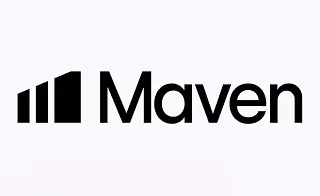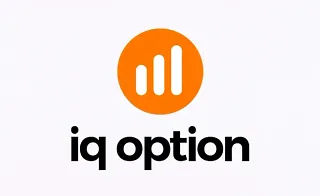RTM Style, short for "Read The Market" is an analytical method in financial markets that, instead of relying on indicators, examines price behavior based on market structure, liquidity, and order flow. Focus of this style in technical analysis is on identifying points where large market players enter or exit.
In RTM Style, the trader doesn't predict price movement but analyzes it as the result of supply, demand, liquidity absorption, or liquidity removal. Tools such as price nodes, compressions, structure breaks, and candle types help improve the understanding of this process.
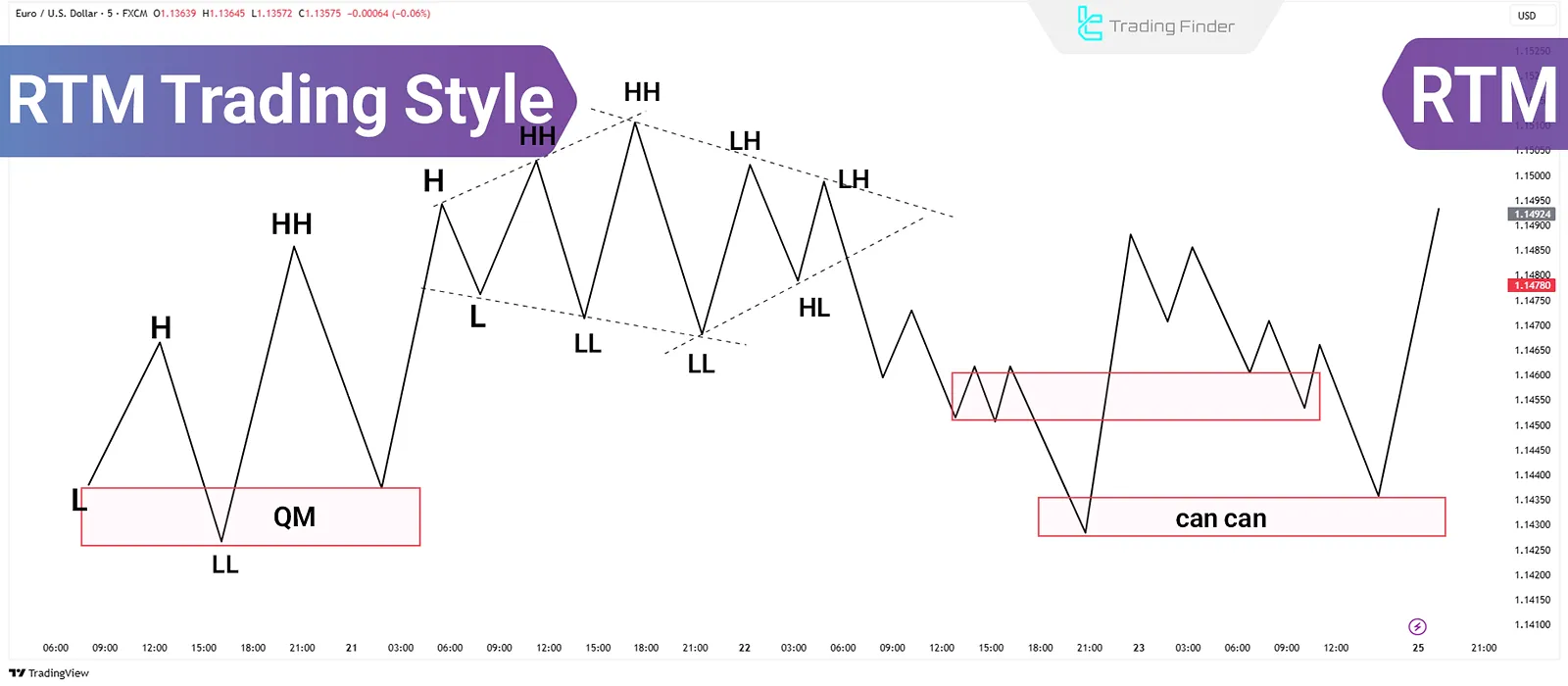
What Is RTM Style?
In RTM Price Action, the focus is on identifying specific zones where large investors have made heavy entries or exits. These zones, referred to as price nodes, only gain significance when analyzed alongside market structure, candle types, and liquidity.
This style uses various tools to demonstrate how large volumes of capital move without leaving obvious traces. The most important tools in RTM Style include:
- Price structures such as RBR, DBD, and others
- Supply and Demand Zones
- Identification of Momentum and Base Candles
- Liquidity behaviors such as stop hunts and compressions (CP)
- The role of price nodes combined with the concept of Nested Zones
Ultimately, the goal of RTM is to identify entry points with low stop-losses based on actual market behavior.
Table of Advantages and Disadvantages of RTM Style
Before learning and applying RTM Style, price behavior, and order flow analysis, one must understand its strengths and weaknesses:
Advantages | Disadvantages |
Accurate identification of large market players' behavior | Requires time and experience to master the concepts |
Focus on market logic instead of external tools like indicators | Highly complex for beginner traders |
Offers high risk-to-reward ratio in trades | Low win rate if analysis is executed poorly |
Applicable across all timeframes and markets (Forex, Crypto, etc.) | High chance of counter-trend trades if higher timeframes are ignored |
Detailed analysis of decision-making zones and liquidity | High potential for misinterpretation of structures without proper training |
Ability to filter weak zones using key factors | Lack of comprehensive educational standards and scattered learning resources |
Candles in RTM Style
In RTM Style, candle analysis is based on their dominance over one another rather than their names or visual patterns. For example, if a bullish green candle fully engulfs the previous bearish candle, it indicates the buyers' dominance in the market. Candles used in RTM include:
- Base Candles
- Momentum Candles
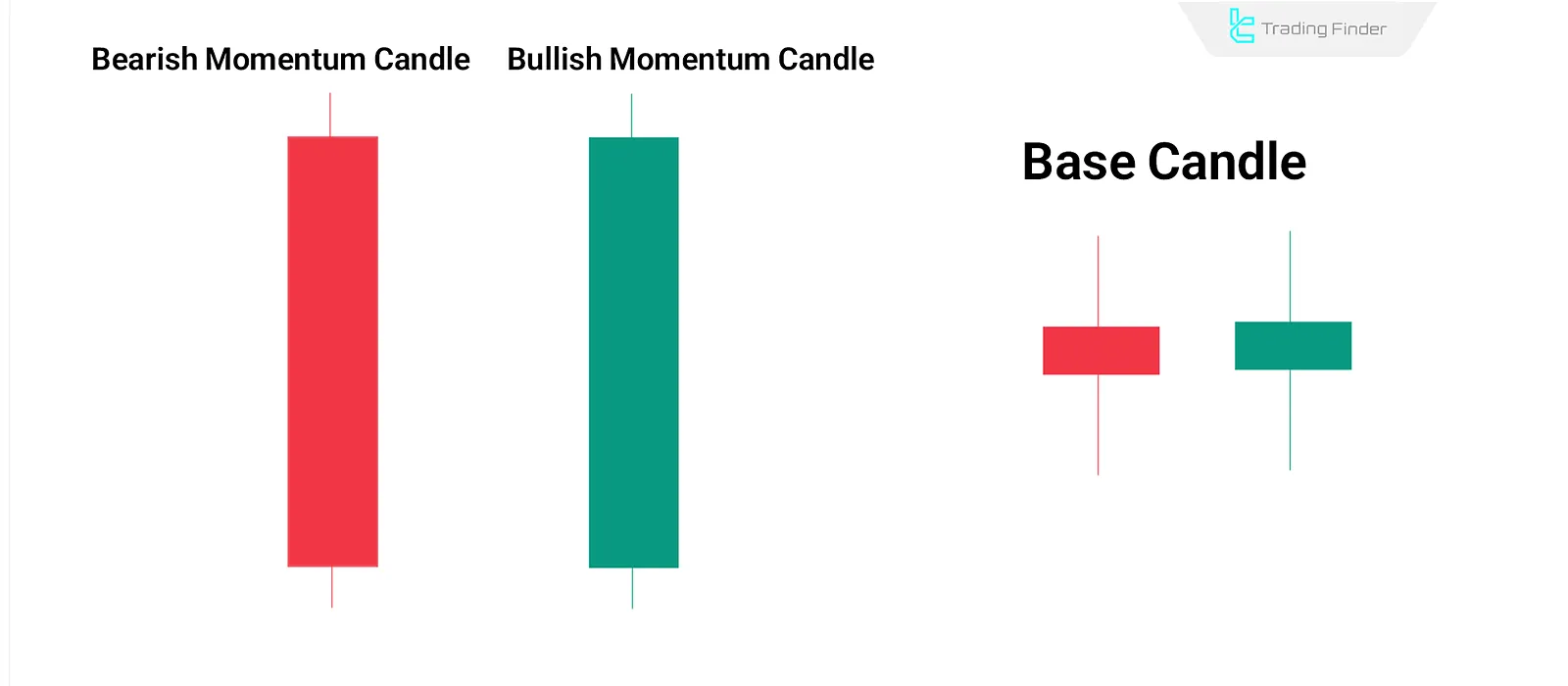
RTM Base Candle
A Base Candle reflects a moment of relative balance between buyers and sellers. This candle usually forms before or after sharp price movements.
Key characteristics of a Base Candle:
- Smaller body compared to the total wick length
- Bullish or bearish color does not affect zone analysis
- Indicates price pause, compression, or preparation for the next move
- Forms the basis for drawing supply and demand zones in RTM structures
RTM Momentum Candle
A candle that signals clear dominance of one market side (buyers or sellers).
Key characteristics of a Momentum Candle:
- Body larger than the total wick length
- Short or no wicks (no wick is ideal)
- Clear directional bias; e.g., bullish candle opens low and closes high with strong buying pressure
- Fast and decisive price movement
Differences Between Momentum Candle and Base Candle in RTM Style
Recognizing the difference between Momentum and Base Candles is essential in using RTM Style. This distinction forms the foundation for identifying core market structures.
Characteristic | Momentum Candle | Base Candle |
Body | Large | Small |
Wicks | Short or none | Typically long |
Price Behavior | Strength and dominance | Pause and balance |
Usage | Confirms trend direction | Basis for zone drawing |
Core Concepts of RTM Style
Three core concepts form the analytical foundation of RTM Style, and understanding them enables precise market analysis and high-probability entries:
- Market Structure
- Supply & Demand Zones
- Liquidity
Market Structure in RTM Price Action
Market structure reveals the price's directional movement, helping identify the dominant trend and reversal points. Core elements include:
Higher High (HH) and Higher Low (HL)
If new highs and lows are formed above the previous levels, the trend is bullish, indicating buyers are in control and pushing prices upward.
Lower Low (LL) and Lower High (LH)
If each new low and high is lower than the last, the market is in a bearish trend, signaling stronger sellers and a desire to push prices downward.

Structure Break in RTM Method
When a price breaks an important high or low in the direction of the current trend, it's called a Structure Break. This confirms trend continuation and is a key sign in RTM analysis.
Trend Reversal in RTM Style
A break of a significant high or low for the first time signals the end of the current trend and the potential of beginning a new trend. For example, if the price breaks a key low during an uptrend, it could mark the start of a downtrend.
Supply & Demand Zones in RTM Price Action
These zones are areas where the imbalance between buyers and sellers causes price reversals. Key components:
Demand Zone in RTM
A region on the chart where price previously rallied strongly. This indicates strong buy orders and may again fuel price growth.
Supply Zone in RTM
A region from which prices previously dropped sharply. Signifies seller dominance and may again push prices lower.
How to Precisely Draw Zones in RTM Style?
Supply and demand zones are typically drawn by combining Base Candles and Momentum Candles. The range between the last neutral candle (base) and the first strong impulse candle is defined as the zone. The faster and stronger the movement from the zone, the more valid it is.

Hidden Orders
RTM Style assumes some buy or sell orders remain in these zones, and prices may react again upon returning to them.
Liquidity in RTM Style
Liquidity is not just a side factor but a target for price movement. In RTM, liquidity is seen as the fuel that powers price. The analyst must identify where the market is heading for liquidity and where it's most likely to be absorbed.
Stop-Loss Clusters in RTM Price Action
Behind major highs and lows, numerous stop losses are typically placed. Market makers target these zones because triggering stops injects liquidity into the market.
Stop Hunt in RTM
Sometimes, price swiftly moves into certain zones to trigger stop-losses. This movement is typically short-term and temporary, but its primary goal is to absorb liquidity for the continuation of the main trend.
The Four Market Structures in RTM Style
The four core structures in RTM Price Action represent the most fundamental price movements. These patterns help identify decision-making zones and potential reversal or continuation points. Each structure consists of two upward and two downward movements. Key RTM Style structures include:
- Rally–Base–Rally (RBR)
- Drop–Base–Rally (DBR)
- Drop–Base–Drop (DBD)
- Rally–Base–Drop (RBD)
Rally–Base–Rally (RBR) in RTM Method
Price rallies upward enters a base phase (balance), and then continues its bullish movement with greater momentum. This indicates active buyers with strong momentum.
Use Cases of RBR:
- Entry after a pullback to the base zone for long positions
- Ideal for sustained bullish trends
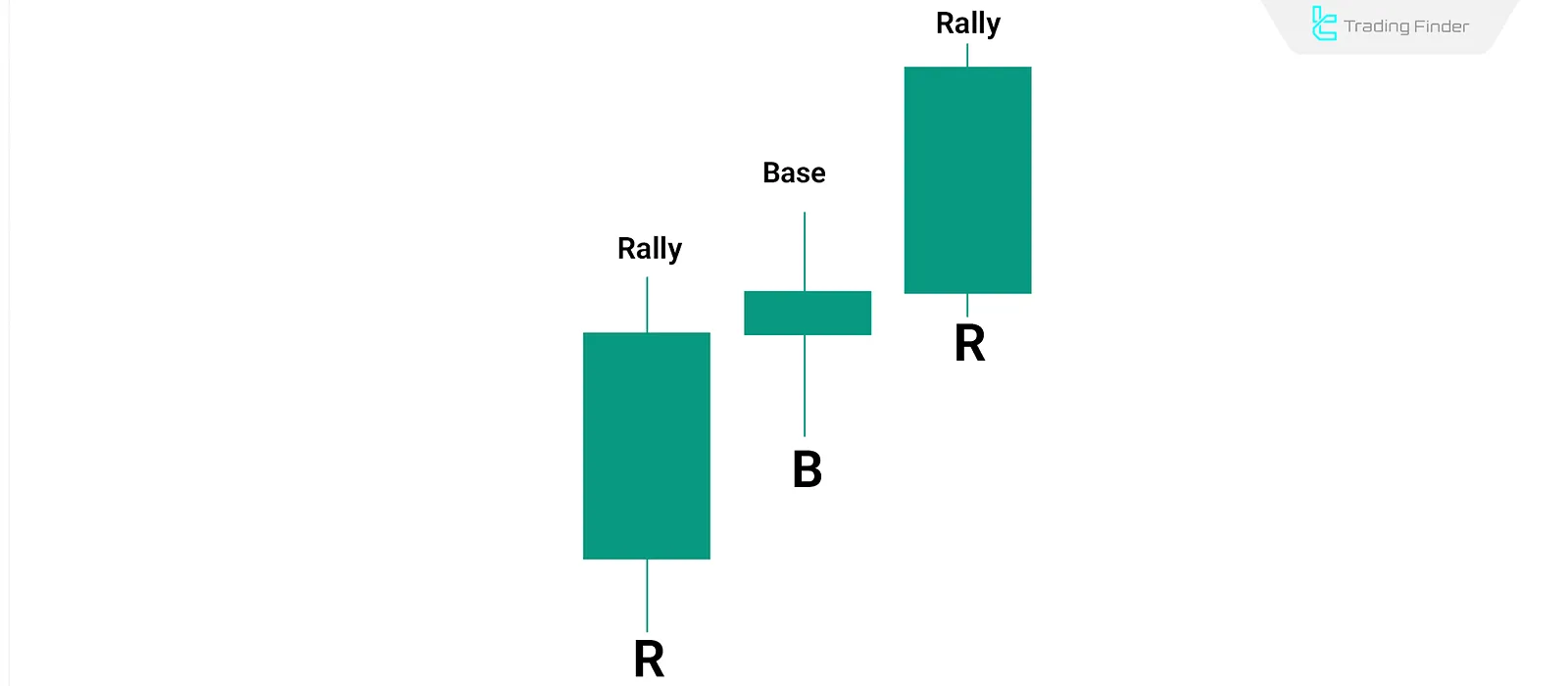
Drop–Base–Rally (DBR) in RTM Style
Price drops (Drop), stabilizes in a base, then reverses upward (Rally). This reflects buy order absorption and the end of selling pressure.
Use Cases of DBR:
- Effective for identifying the end of bearish corrections
- Base zone typically hosts leftover buy orders
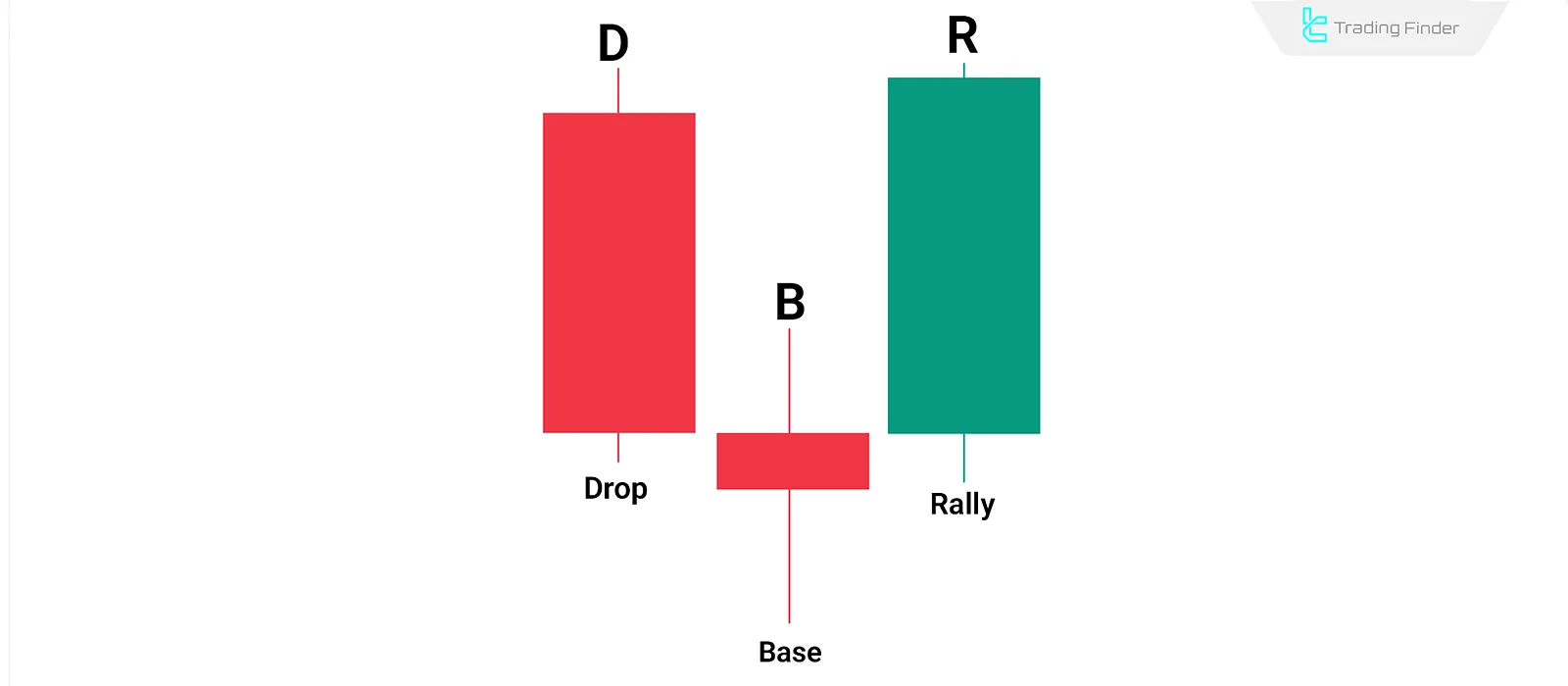
Drop–Base–Drop (DBD) in RTM
Price falls due to selling pressure, pauses in a base, then continues falling as sellers return. This structure signals full seller control.
Use Cases of DBD:
- Entry for short positions after a retest of the base
- Indicates a strong bearish trend with high validity
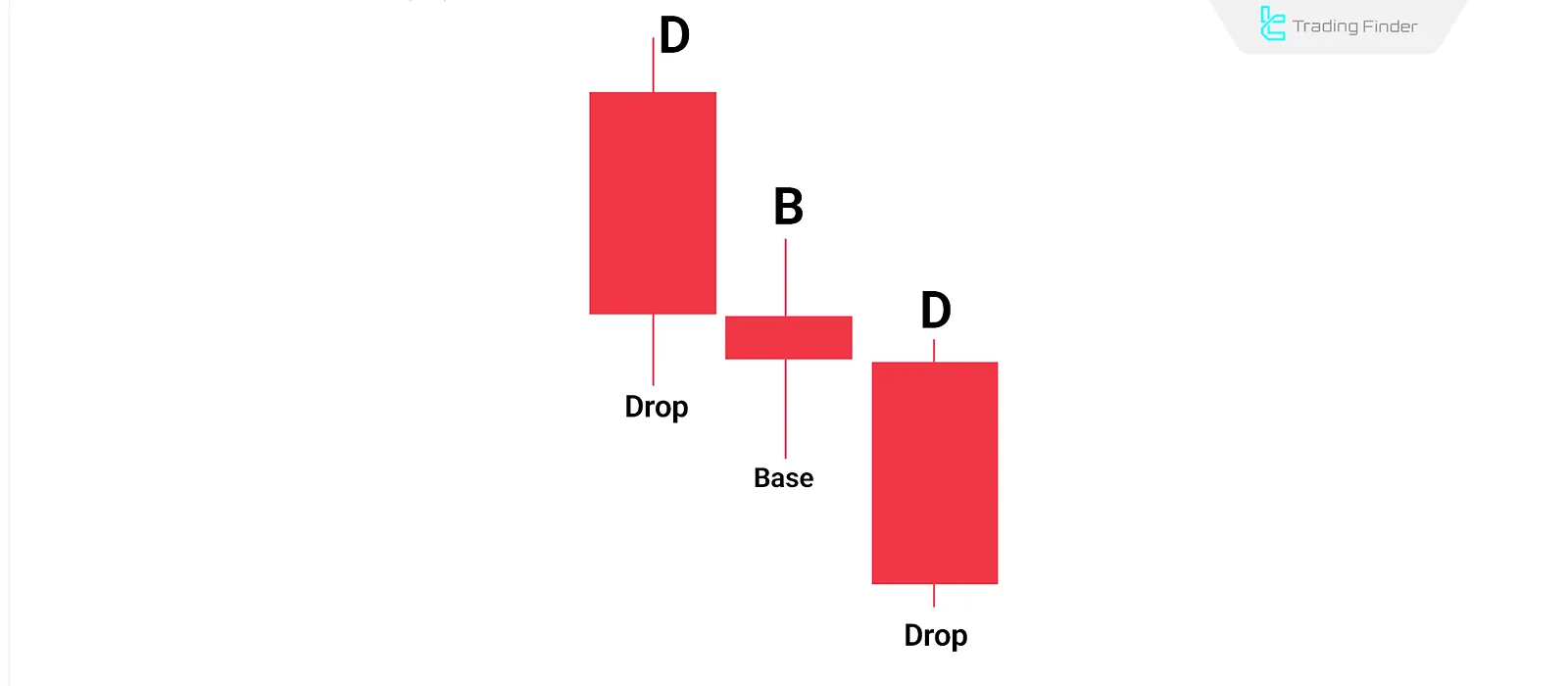
Rally–Base–Drop (RBD) in RTM
Price initially rallies, pauses in a base, then drops as selling pressure enters. This indicates buyer exhaustion and new selling interest.
Use Cases of RBD:
- Useful for identifying the end of rallies
- The base zone becomes an ideal entry point for short trades

Zones in RTM Style
In RTM, certain supply and demand zones carry more significance. Based on their formation and how price has interacted with them, zones are categorized into three types:
- Authentic Zone
- Reaction Zone
- Fresh Zone
Authentic Zone in RTM Style
In RTM Price Action, an Authentic Zone is a region where, for the first time, a strong imbalance between buyers and sellers caused a powerful price move.
This zone is not based on reactions to old structures. Instead, it acts as the original source of major orders and does not overlap any previous zone. As a result, it’s considered the most valid and reliable zone in RTM.

Reaction Zone in RTM Method
Reaction Zone is an area that the price has previously reacted to and where a new structure now forms. It typically overlaps an older zone and may trigger another reaction due to unfilled historical orders.
Since it's not the origin of the first move, this zone is less reliable than an Authentic Zone and requires more confirmation, especially on lower timeframes, before entering a trade.

Fresh Zone in RTM
A Fresh Zone in RTM Style is a region that, after being formed, has not yet been touched by price. Because no orders have been triggered there, it has the highest potential to cause a strong reaction upon the first touch.
This initial touch, called FTB (First Time Back), is often a high-probability reversal point. Therefore, Fresh Zones are prioritized over tested zones when looking for trades in RTM Price Action.
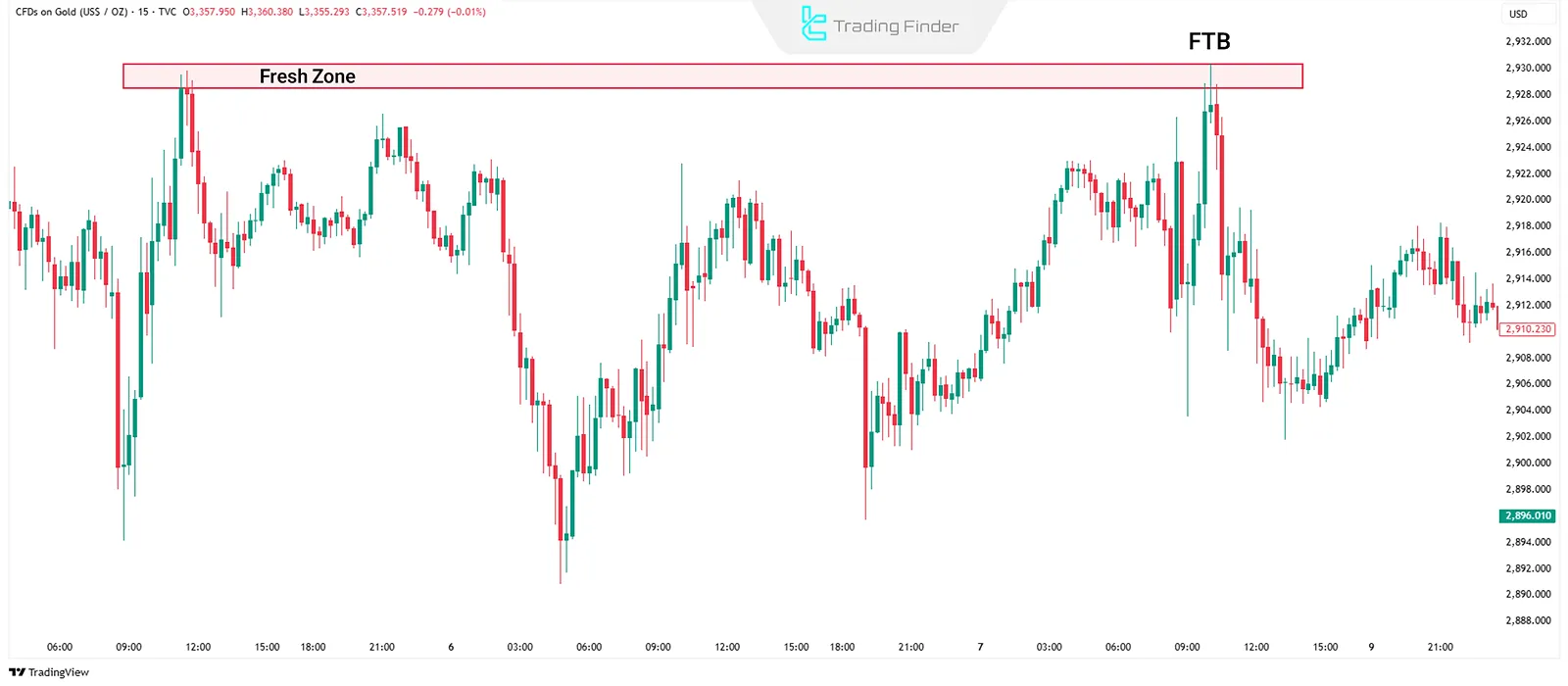
Criteria for Zone Validity in RTM Price Action
In RTM, the validity of a zone is not based on appearance alone. Instead, it depends on how the price behaves around that area and whether it shows potential for reversal or continuation.
Base Candle Quality in RTM Style
To consider a zone valid in RTM, it must start with a clear, high-quality base candle—where the market pauses and shows a relative balance between buyers and sellers.
If the base is too large, extended, or made up of multiple candles, the zone’s validity weakens. Even if there’s a strong breakout or it’s a Fresh Zone, it can't be trusted unless the base is compact, clear, and well-defined. Without that, analyzing other factors becomes irrelevant.
Departure Strength in RTM Style
One of the most important indicators of a zone's validity in RTM Style is how the price departs from it. If the price exits the zone with a series of strong and consecutive momentum candles, it indicates the presence of significant orders and a clear market imbalance.
Conversely, if the price leaves the zone with just a single weak candle and then pauses or reverses, it's likely that the zone is weak or lacks sufficient liquidity. Therefore, a strong, impulsive departure is a clear sign of zone credibility and heavy decisions made by major players.
Alignment with Higher Timeframe Trend in RTM Method
Respecting the higher timeframe trend plays a key role in validating zones within RTM. If the direction of price movement in the analyzed timeframe matches the higher timeframe trend, there is a greater chance the zone will react effectively, and the price will continue moving in the same direction.
This alignment indicates that the trade is in the direction of dominant liquidity flow.
On the other hand, if the analyzed timeframe contradicts the higher timeframe trend—even if the zone appears structurally sound—there is a higher risk of invalidity or sudden reversal. Thus, aligning with higher timeframe trends is a crucial method for reducing trade risk in RTM Price Action.
Types of Setups and Patterns in RTM Style
In RTM Style Training, trading setups are defined based on price behavior within key zones and structure breaks. These setups form the core of trade entries and are each based on liquidity logic and reactions from large market participants.
Engulfing Pattern in RTM
The Engulfing pattern in price action is one of the clearest signs of a shift in control between buyers and sellers. This pattern occurs when one candle completely engulfs the previous candle in terms of opening and closing.
If the second candle is bullish and fully covers the previous bearish candle, it's called a Bullish Engulf, indicating strong buyer entry and likely upward movement. Conversely, if the second candle is bearish and engulfs a bullish candle, it forms a Bearish Engulf, suggesting a potential price drop.
In RTM Style, engulfing is not limited to candles. A sudden and powerful break of a supply or demand zone is also considered a structural engulf. It is a critical tool for identifying trend reversals, big player entries, and zone validation.

FL (Fail to Return) Setup in RTM
The FL Setup is a widely used entry pattern in RTM Style, built on the strong break of key Support and Resistance (SR) zones, forming a new valid trading area.
As the price approaches an important SR zone, it often pauses briefly, forming tight base candles. After breaking the zone—often forming a structure like DBD or RBR—a new area forms on the broken SR level, known as the FL Zone.

Key Traits of the FL Setup
A strong and fast departure from the SR zone, Minimal pause before the break and indicates untriggered pending orders that react on retest.
Sometimes, the base candle is unclear; switching to a lower timeframe helps identify it. If a gap forms without a visible base, the gap itself may indicate rapid price departure—though this adds risk.
Ultimately, an FL setup is valuable when the break of the SR zone is fast and decisive, allowing for low-risk entries on the retest.
FTR (Fail to Return) Pattern in RTM
The FTR Setup is a continuation pattern in RTM Price Action based on the price failing to return to a broken SR zone.
Price first engulfs an SR level with a momentum candle, then continues and creates a new SR. On the pullback, it fails to reach the original SR, instead pausing nearby and forming a base candle, creating what's known as the FTR Zone.
Price then breaks the second SR with force. On returning to the FTR Zone, it often reacts strongly, offering a trade entry. This setup is marked by two consecutive breaks in the new trend's direction—a sign of strength.
If the FTR Zone is later broken in the opposite direction, it may signal trend exhaustion and the beginning of a new structure.

Caps Pattern in RTM Price Action
The Caps Pattern in RTM Style is a reversal setup that forms near-market highs. Price first rises with momentum, and professional traders take partial profits, causing a minor correction. Price then climbs again, luring inexperienced traders into false long positions.
At this point, smart money absorbs liquidity and executes heavy selling, reversing the trend. The zone formed before the drop becomes the Caps Zone, suitable for high-risk-to-reward short entries.
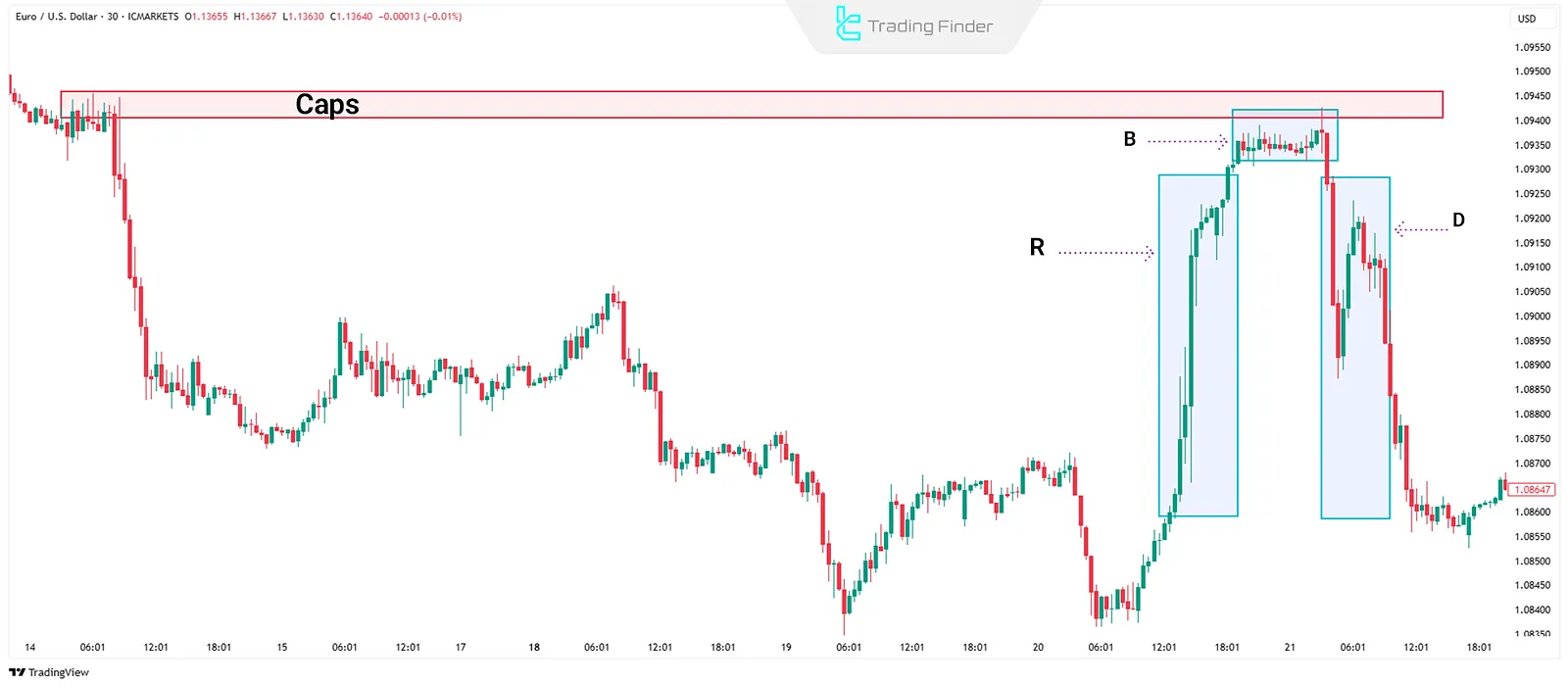
Swap Setup in RTM
In the Swap Setup, a strong supply or demand zone changes role when the price breaks it powerfully with momentum. The former supply becomes demand, or vice versa.
This occurs as retail traders enter trades against the trend, only for the price to break through the zone, triggering their stop-losses. Later, when the price returns to the broken zone, these same traders now join the trend, reinforcing the zone's new function.

PAZ (Price Action Zone) Pattern in RTM
In RTM Style, the PAZ (Price Action Zone) forms between two key structures, such as FL or FTR. This zone typically emerges after the price breaks a previous structure against the dominant trend using a momentum move, suggesting entry into a liquidity vacuum.
Once inside the PAZ, the price often continues toward the next major structure. This zone signals a shift in order flow or trader sentiment and may offer short-term trading opportunities—though it is not ideal for major entries unless confirmed by other RTM elements.
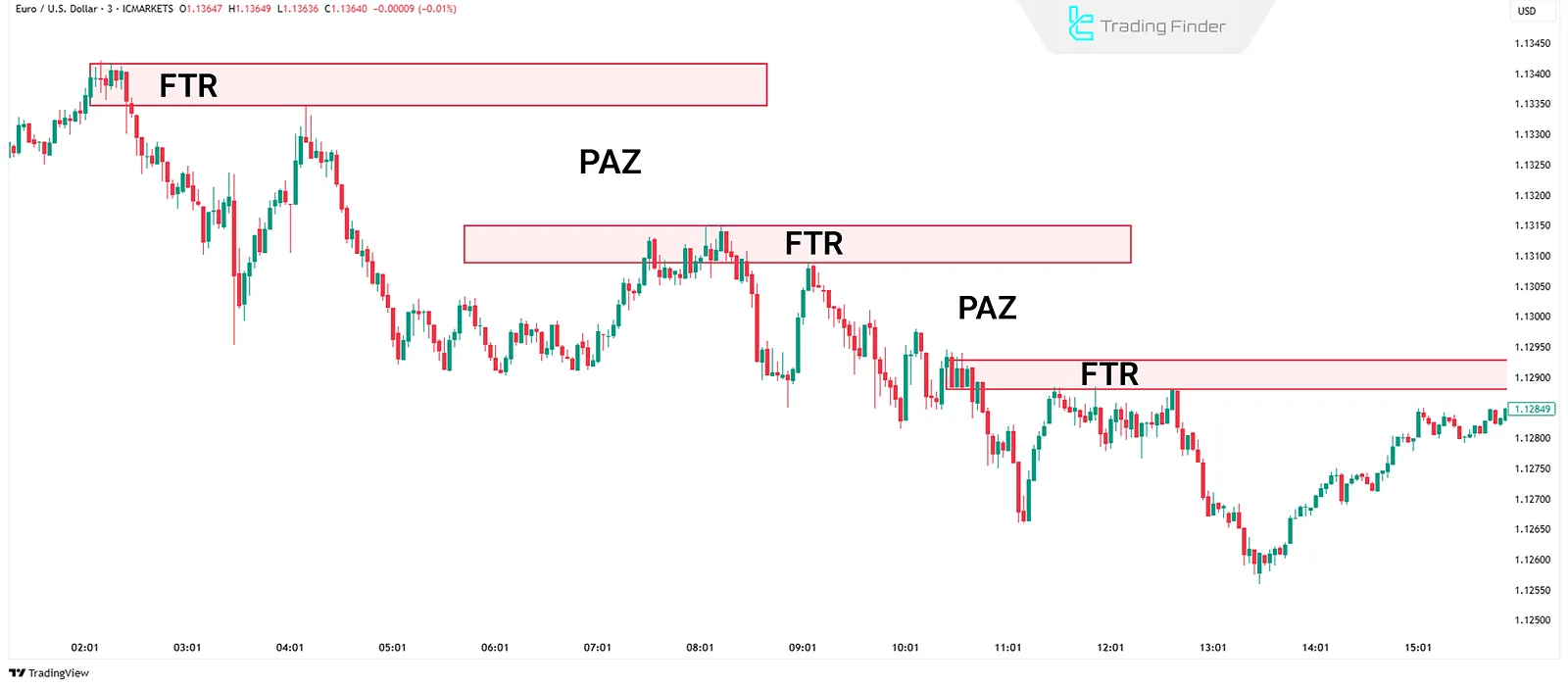
3Drive Setup in RTM Price Action
The 3Drive pattern in RTM is a confirmation structure that analyzes price behavior before reaching a major supply or demand zone. Price forms three consecutive highs or lows, each with diminishing momentum, indicating trend exhaustion.
Though similar to Compression, the 3Drive focuses more on the number of waves. It's a sign of market fatigue, and when the price reaches the target zone, a reversal is likely.
This pattern is not used as a standalone trade entry but rather serves as a confirmation of the strength of a supply or demand zone. When combined with other signals, it enables a more accurate analysis of potential price reversals.
Tip: For ease of use, you can utilize the RTM 3Drive Indicator provided by Trading Finder Team:
- RTM 3Drive Indicator for MetaTrader 4
- RTM 3Drive Indicator for MetaTrader 5
- RTM 3Drive Indicator for TradingView
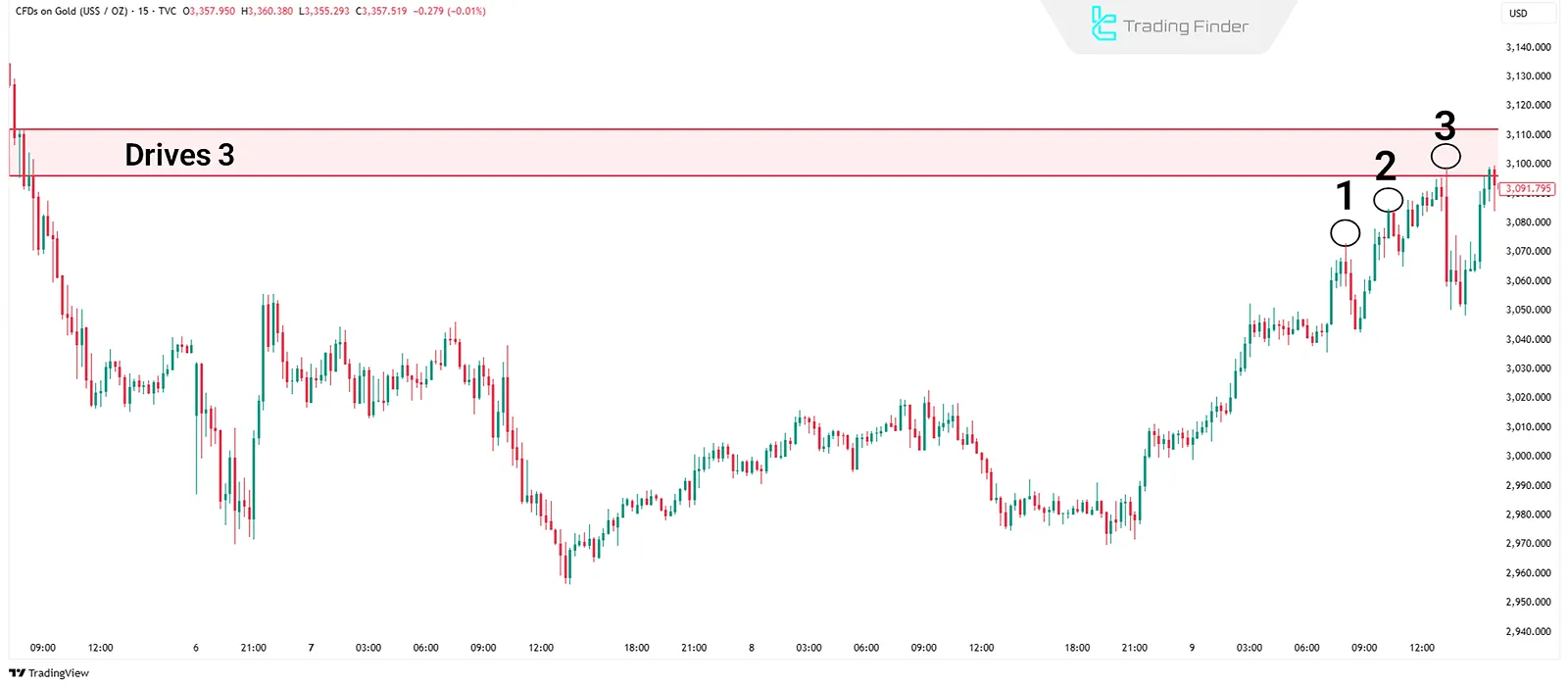
CP (Compression) Setup in RTM Price Action
The Compression Setup in the RTM Style indicates a gradual weakening of the dominant trend and a high probability of sharp reversal.
In this structure, as the price approaches a significant zone, it creates several supply or demand zones that are stacked and repeatedly tested.
These repeated tests drain liquidity, leaving no resistance when the price hits the final major zone—resulting in a strong move in the opposite direction. Demand-side compression leads to a rally, then a drop, then another rally. Supply-side compression results in a drop, rally, then another drop.
The power of this setup depends on, The number of tested zones, The depth and quality of price reactions.
Compression is most useful as a confirmation of strong zones, as it reflects liquidity absorption and market preparation for a major move.
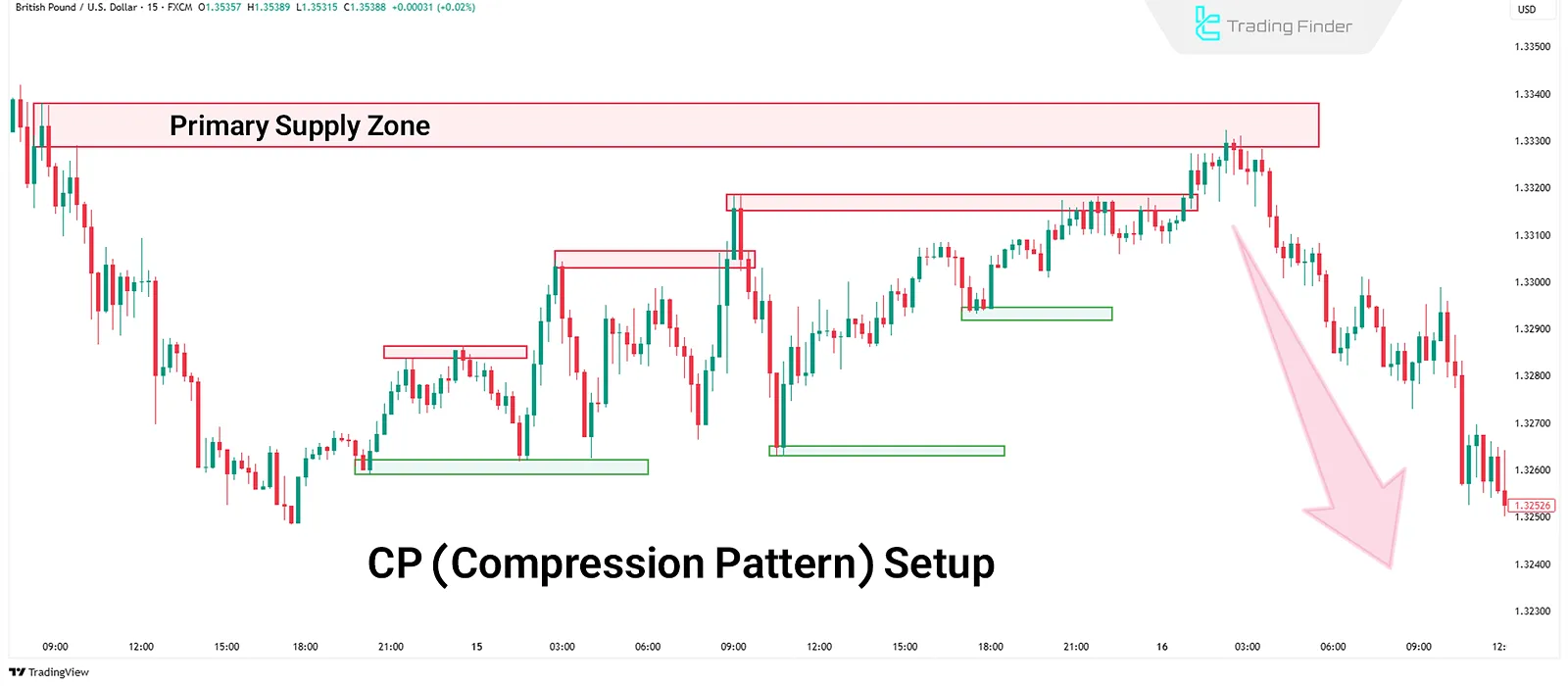
Quasimodo (QM) Pattern in RTM Style
The QM pattern in RTM is a reversal structure based on consecutive structure breaks and trader manipulation. It typically appears when the dominant trend is nearing its end, and the price is ready to reverse.
The pattern features two opposite engulfing moves—the first challenges the trend; the second completely invalidates it.
How to Increase QM Pattern Validity
If the final break also engulfs an old supply/demand zone, the likelihood of success is much higher. The QM structure is a precise signal of a true trend reversal.

Bearish QM
The Bearish Quasimodo (QM) pattern begins within an uptrend, where the price forms a Higher High (HH), followed by a pullback to a Higher Low (HL). The market then prints a new, even higher peak (HHH), continuing the bullish structure.
However, in a sudden shift, price breaks below the previous HL, signaling a loss of buyer control and the entry of strong sellers. This structural break marks a potential reversal point. The area between the last two highs (HH and HHH) becomes the QM Supply Zone, a high-probability level for initiating short trades in anticipation of a downward move.
Bullish QM
The Bullish Quasimodo (QM) pattern forms after a series of lower lows, signaling a prevailing downtrend. Suddenly, the price engulfs the previous high, indicating a shift in market sentiment and the emergence of buyer strength.
This move often traps traders who had entered short positions based on the previous bearish structure, generating the liquidity required for a true reversal. The area between the last two lows becomes the QM Demand Zone, offering a high-probability entry point for long trades as the market transitions into a potential uptrend.
Can Can Setup in RTM
The Can Can Setup is a rare but powerful reversal pattern combining Caps and Compression (CP). It begins with a strong RBR structure and is based in a demand zone.
Surprisingly, price engulfs this demand zone. As it returns to the broken zone (caps), it enters a compression state, forming several consecutive supply or demand areas—marking CP behavior.
When the price reaches the caps zone again, lacking support liquidity, a sharp reversal occurs. This powerful reversal zone is known as the Can Can Zone, marking the end of manipulation and true market direction. This strategy, requires precise structure reading and multi-step confirmations.

QML and MPL in RTM Style
In RTM, QML (Quasimodo Line) is the first peak or trough with a base candle, defining the start of the QM structure.
MPL (Maximum Pain Level) is the second high or low formed afterward—where large amounts of liquidity are trapped. The main price reaction usually happens at the MPL, making it the ideal entry point.

Diamond Pattern in RTM
The Diamond Pattern in RTM is a complex reversal formation combining structure break, trader manipulation, and broken market expectations.
It often follows a QM pattern but differs in that the QM reaction point is engulfed, not respected. Price then extends beyond it.
How the Diamond Pattern Works?
Price reacts to a supply/demand zone and attracts entries but then engulfs the zone, taking liquidity. It then abruptly reverses, breaks trendlines, and initiates the main reversal move.
Its symmetrical structure gives it a diamond-like appearance, making it one of the most deceptive and powerful reversal setups in RTM.
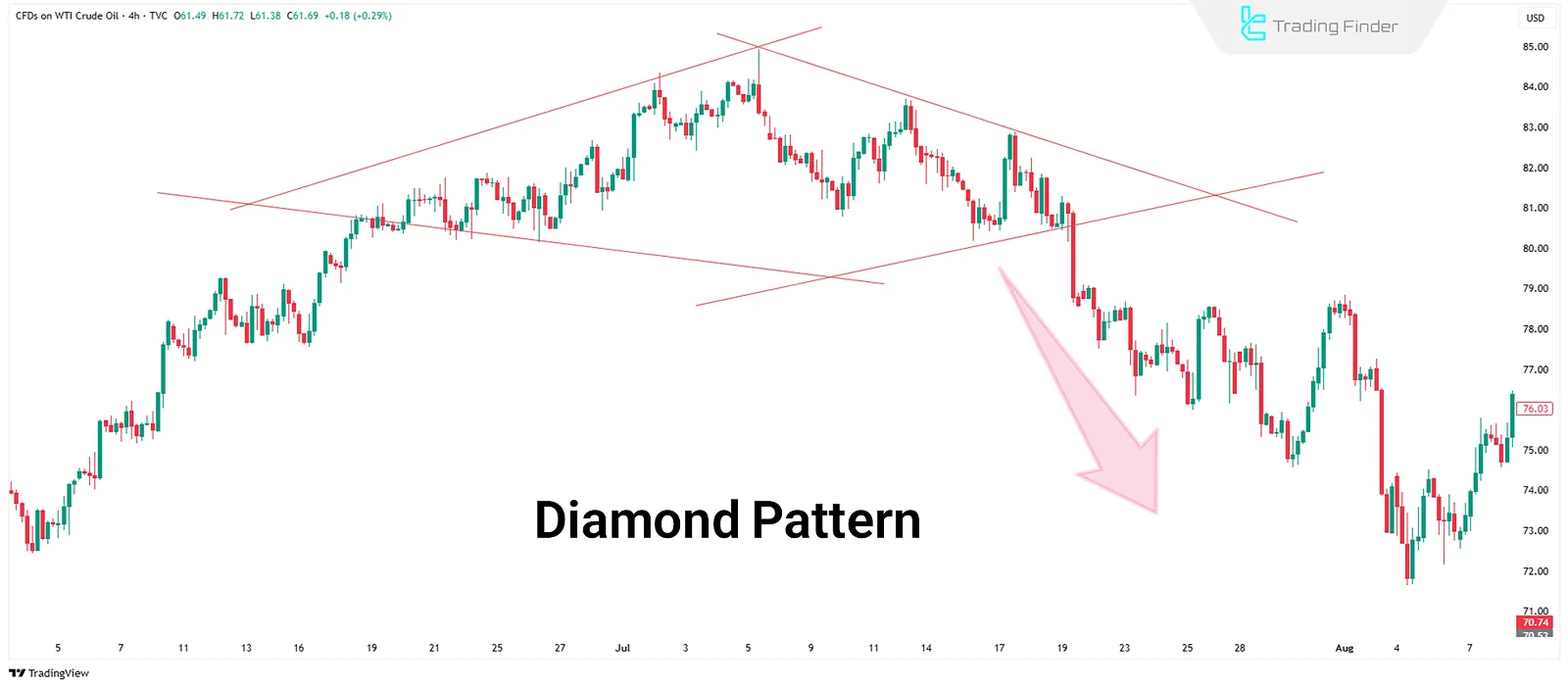
Conclusion
RTM Style provides a methodology to analyze price behavior around key zones using market structure, order flow, and liquidity. Its main focus is on identifying entry and exit points based on the logic of price movement.
By leveraging structures like RBR, DBR, DBD, and RBD, analyzing untouched zones, evaluating candle types, and structure breaks, RTM facilitates precise market interpretation.
Setups such as FL, FTR, QM, CAPS, Diamond, and Can Can help reveal price behavior and zone strength/weakness. The successful application relies on understanding structure sequencing, reaction timing, and position management.

